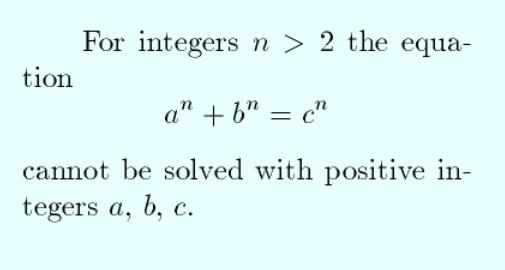Andrew Wiles Fermat Last Theorem Pdf
In 1986 Wiles came to know that the link between the Taniyama-Shimura conjecture and Fermat's Last Theorem had been demonstrated. This seemed to Wiles a golden opportunity to use advanced mathematics (seeking to prove the Taniyama-Shimura conjecture) to attain the mathematical ambition of his life (proving Fermat's Last Theorem). Fermat's last theorem and Andrew Wiles. He then moved on to looking at the work of others who had attempted to prove the conjecture. Fermat himself had proved that for n =4 the equation had no solution, and Euler then extended Fermat's method to n =3. The problem was that to prove the general form of the conjecture. By this argument, the chance that Fermat’s Last Theorem is false is less than 1 in 26,000,000. This might be enough to convince someone, but it is not a proof of Fermat’s Last Theorem! What if Fermat’s Last Theorem were true just for “probabilistic” reasons, and not for a “structural” reason that could lead to a proof?
Andrew Wiles Fermat Last Theorem Pdf 1
This is a clip from 'Fermat's Last Theorem,' featuring Andrew Wiles and of the famous mathematical problem. For hundreds of years, it was one of the most intriguing puzzles in the world. Fermat had solved it—or so he said—but the only clue he left about its solution was this puzzling statement: I have discovered a truly remarkable proof but this margin is too small to contain it.
Professor Wiles had been obsessed with finding the solution to Fermat's Last Theorem since he was a boy. He thought he had attained his goal, in 1993. Simon Singh, one of the makers of 'Fermat's Last Theorem,' provides more background on this story: There is a brilliant genius from the past who solves an apparently impossible problem. He dies without revealing the solution. This becomes buried treasure, and every subsequent mathematician goes in search of it. There are heroes, villains, rivals, rich prizes, a duel at dawn, a suicide and an attempted suicide, but after 300 years the problem remains intact.

The greatest minds on the planet failed to solve it. Undaunted, however, a young boy promises to devote the rest of his life to solving this notorious problem. After thirty years he suddenly identifies a strategy that might work.
For seven years he works in secret. He reveals his proof, only to learn that he has made a mistake. How did Wiles learn of the mistake, after releasing his solution?: Then disaster struck.
His colleague, Dr Nick Katz, made a tiny request for clarification. It turned into a gaping hole in the proof. As Andrew struggled to repair the damage, pressure mounted for him to release the manuscript - to give up his dream. So Andrew Wiles retired back to his attic. He shut out everything, but Fermat. A year later, at the point of defeat, he had a revelation.
'It was the most important moment in my working life. Nothing I ever do again will be the same.' The very flaw was the key to a strategy he had abandoned years before. In an instant Fermat was proved; a life's ambition achieved; the greatest puzzle of maths was no more. When Andrew Wiles talks about that moment of revelation—when he realized that he'd solved what had seemed impossible to solve—he becomes very emotional.

(See the beginning of this clip.) In March of 2016, something else. He has won the prestigious for his work in solving Fermat's Last Theorem. In the world of mathematics, is like winning a Nobel Prize. Is it possible to understand Fermat's Last Theorem, and its solution, even if we're not math geniuses? Here is, from the Abel-Prize website. To watch the entire documentary, 'Fermat's Last Theorem,' which is available on Vimeo.

For a slightly higher resolution,.